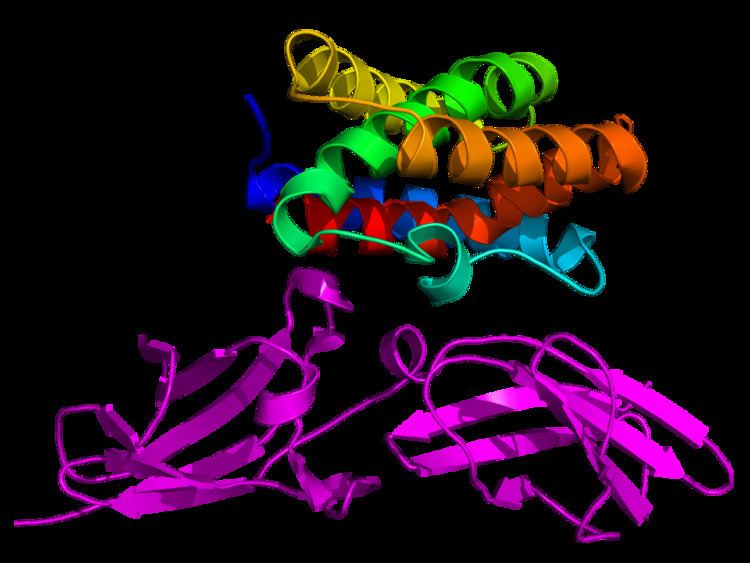Entrez 50616 | Ensembl ENSG00000127318 | |
 | ||
Aliases IL22, IL-21, IL-22, IL-D110, IL-TIF, ILTIF, TIFIL-23, TIFa, zcyto18, interleukin 22 External IDs OMIM: 605330 MGI: 1355307 HomoloGene: 9669 GeneCards: IL22 | ||
Structure
IL-22 is an α-helical cytokine. IL-22 binds to a heterodimeric cell surface receptor composed of IL-10R2 and IL-22R1 subunits. IL-22R is expressed on tissue cells, and it is absent on immune cells.
Crystallization is possible if the N-linked glycosylation sites are removed in mutants of IL-22 bound with high-affinity cell-surface receptor sIL-22R1. The crystallographic asymmetric unit contained two IL-22-sIL-22R1 complexes.
Function
IL-22 a member of a group of cytokines called the IL-10 family or IL-10 superfamily (including IL-19, IL-20, IL-24, and IL-26), a class of potent mediators of cellular inflammatory responses. It shares use of IL-10R2 in cell signaling with other members of this family, IL-10, IL-26, IL-28A/B and IL-29. IL-22 is produced by activated NK and T cells and initiates innate immune responses against bacterial pathogens especially in epithelial cells such as respiratory and gut epithelial cells. IL-22 along with IL-17 is rapidly produced by splenic LTi-like cells and also produced by Th17 cells and likely plays a role in the coordinated response of both adaptive innate immune systems, autoimmunity and tissue regeneration.
IL-22 biological activity is initiated by binding to a cell-surface complex composed of IL-22R1 and IL-10R2 receptor chains and further regulated by interactions with a soluble binding protein, IL-22BP, which shares sequence similarity with an extracellular region of IL-22R1 (sIL-22R1). IL-22 and IL-10 receptor chains play a role in cellular targeting and signal transduction to selectively initiate and regulate immune responses. IL-22 can contribute to immune disease through the stimulation of inflammatory responses, S100s and defensins. IL-22 also promotes hepatocyte survival in the liver and epithelial cells in the lung and gut similar to IL-10. In some contexts, the pro-inflammatory versus tissue-protective functions of IL-22 are regulated by the often co-expressed cytokine IL-17A
Target tissue
Targets of this cytokine are mostly non-hematopoietic cells such as hepatocytes, keratinocytes, and lung and intestinal epithelial cells. Pancreatic islets also express high levels of IL-22 receptor. It has been shown to induce islet beta cell regeneration.
Signaling
IL-22, signals through the interferon receptor-related proteins CRF2-4 and IL-22R. It forms cell surface complexes with IL-22R1 and IL-10R2 chains resulting in signal transduction through receptor, IL-10R2. The IL-22/IL-22R1/IL-10R2 complex activates intracellular kinases (JAK1, Tyk2, and MAP kinases) and transcription factors, especially STAT3. It can induce IL-20 and IL-24 signaling when IL-22R1 pairs with IL-20R2.
